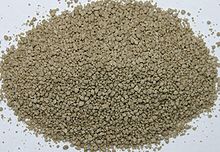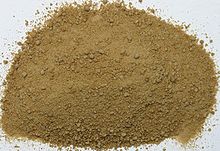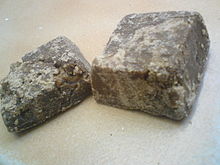Whole cane sugar

Whole cane sugar (also: Muscovado or Mascobado ) is an unrefined type of sugar that is obtained from the juice of the sugar cane by filtering , thickening, drying and grinding. Depending on the clarification, the end product is gray to deep brown. Whole cane sugar has a characteristic taste of its own and consists of 91% sucrose .
Originally the juice was not clarified, which meant that minerals, vitamins and flavorings remained in the end product. Some manufacturers clarify the sugar juice by means of lime-carbonic acid cleaning, after which these ingredients are partially removed.
The inherent taste is described as caramel, but also as licorice. In finished products, it can occasionally be found in nut nougat cream, chocolate, cocoa-based drink powders or mueslis. It is suitable for sweetening beverages, pastries, desserts, savory dark sauces as well as for stews and strong dessert sauces. The product is mainly sold in organic trade and is also traded fair trade .
Whole cane sugar is used as a traditional sweetener in Asia and South America and is also used as a medicine in India. In these countries, sugar cane juice is still boiled over an open fire.
There is research that suggests that whole cane sugar is less cariogenic ( caries-causing ) than white sugar. This includes records from M.-H. Béguin between 1968 and 1986 and in vitro experiments by Osborn et al. Other researchers, however, come to the conclusion that there is no difference in the cariogenicity of white and whole cane sugar or that the caries-promoting properties outweigh the caries-inhibiting properties. The brown sugar has no significant physiological advantages over white sugar. The occurrence of contaminating foreign matter is discussed critically.
Individual evidence
- ↑ Öko-Test magazine 11/90, pp. 34–37, ÖKO-TEST Verlag GmbH, Frankfurt am Main.
- ↑ Karthikeyan, J and S. Sankar Samipillai: Sugarcane in therapeutics ( Memento of the original from March 31, 2014 in the Internet Archive ) Info: The archive link was inserted automatically and has not yet been checked. Please check the original and archive link according to the instructions and then remove this notice. (PDF; 65 kB) In: Journal of Herbal Medicine and Toxicology 4 (1) 9-14 (2010).
- ^ Edmund Oskar von Lippmann: History of sugar, its presentation and use, from the earliest times to the beginning of beet sugar production: a contribution to the cultural history of Leipzig: Hesse, 1890.
- ↑ M.-H. Béguin and M. Schouker: Prevention of dental caries with natural unrefined food. In: Advances in Dental Research 1995. 9. 152. 028. Switzerland and France.
- ↑ TWB Osborn, JN Noriskin and J. Staz: A comparison of crude and refined sugar and cereals in their ability to produce in vitro decalcification of teeth In: Department of Physiology University of the Witwatersrand, Johannesburg, South Africa.
- ^ Marguerite A. Constant, Paul H. Phillips and CA Elvehjem: Dental caries in the cotton rat. xii. Natural versus refined sugars. In: J. Nutr. 1951, vol. 43, no. 4, pp. 551-564.
- ^ Paula Moynihan: Foods and factors that protect against dental caries In: Nutrition Bulletin 2000; Volume 25 Issue 4, pp. 281-286.
- ↑ Waldemar Ternes , Alfred Täufel, Lieselotte Tunger, Martin Zobel (eds.): Food Lexicon . 4th, comprehensively revised edition. Behr, Hamburg 2005, ISBN 3-89947-165-2 .
literature
- Max H. Béguin, Etienne Fernex: Natural food, healthy teeth . Edition de l'Etoile 1979. Violette Béguin. La Chaux-de Fonds. pdf ISBN 2940230013
- Max H. Béguin: Whole cane sugar, for the sake of your teeth . Edition de l'Etoile 1997. Violette Béguin. La Chaux-de Fonds. pdf ISBN 2-940230-03-X


